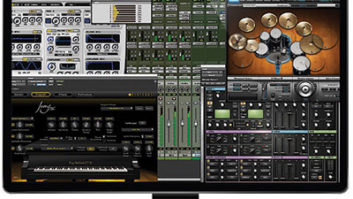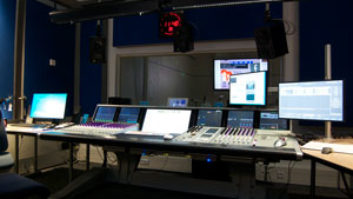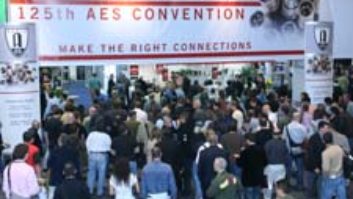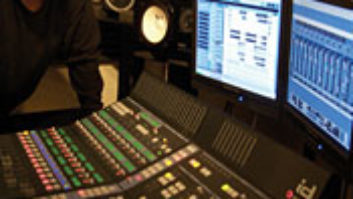CONSIDERATIONS FOR GETTING IT RIGHT THE FIRST TIMEDigital Audio Workstations (DAWs) have become the Swiss Army Knife of professional audio. In the past 18 to 24 months, the availability of fast, relatively inexpensive hard drives and the arrival of ever-faster host processors and data bus speeds have created a market in which the benefits of random access, such as advanced editing functionality and ability to rapidly locate to any point within a project, are now within reach of more musicians and audio professionals than ever before. DAWs now come in an astounding variety of packages and at an equally confusing number of price points – knowing what to look for before you part with your hard-earned cash can go a long way toward ensuring that your purchase is right for your application.
COMPUTER-BASED OR DEDICATED HARDWARE?One of the foremost considerations when purchasing a DAW is the type of platform you want. Do I go with a computer-based DAW, and if so, should I choose a Mac or a PC/Windows system? Should I choose dedicated hardware from a manufacturer I like? The answers to these questions depend on a number of factors – among them the type of work you perform, the level of file compatibility you need to accept and deliver projects with your clients, the type of “environment” where you feel most comfortable and (dare I say it?) your financial resources. There are advantages and disadvantages for any option you choose.
Dedicated hardware carries a number of benefits. For starters, the user interface, from the control surface to the system’s various functions, is dedicated to one particular task – manipulating digital audio. In the heat of an important tracking session, there is a certain “comfort level” gleaned from the availability of real transport controls, jog dials and track arming buttons. Because dedicated hardware is made with one particular task in mind, these systems tend to be less prone to crashes.
On the down side, the ability to update and expand dedicated systems does not always carry the same level of flexibility provided by computer-based workstations. Granted, newer models frequently offer Ethernet or some other provisions to gain access to downloaded updates via the Internet. Nonetheless, you are largely dependent on one particular manufacturer to advance the system.
Because all DAWs, computer or hardware based, use software to execute their functions, how that software and its user interface interact with the end-user is a highly critical consideration. For the most part, software is as good as it coincides with your particular approach to problem solving. For the same reason that some people prefer Intuit’s Quicken to Microsoft’s Money for their financial record keeping, your ability to interact intuitively with the software that operates your DAW is of paramount concern. If the software doesn’t “click” with the way you think, your experience is likely to be less than wonderful.
That said, before you purchase a dedicated hardware unit, make certain that the software approaches digital audio’s various tasks in a manner consistent with what you expect to find. If it doesn’t – think carefully. It’s much easier to exchange computer software than to expect the manufacturer of a hardware solution to rewrite the program so that it suits your expectations.
Computer-based DAWs carry the advantage of running the widest array of software. As previously stated, if Brand X’s approach doesn’t quite coincide with the way you think, then perhaps Brand Y’s software will offer a better solution. In terms of whether to opt for a Mac or a PC, find the software that best suits your manner of working, then get the computer that runs that software.
Another advantage to using a computer-based DAW is that more often than with stand-alone systems, you will find a wider selection of input/output (I/O) options. Perhaps when you first start out, eight channels of ADAT Lightpipe digital I/O best suit your requirements. But what happens if you decide you’d like 24 independent tracks/channels of AES/EBU digital I/O so that you can take advantage of the features on that new console you’ve had your eye on? Chances are, you’ll be able to alter your I/O configuration easier with a computer than with dedicated hardware.
Unfortunately, computers have an annoying tendency to crash when you can least afford it. Not that this should scare you away, but it should force you to consider what can realistically be expected from even the most powerful computer. Although, in theory, you should be able to use your computer to manage your studio’s accounts receivables and payables as easily as you use it for audio work, in practice this is probably not the best idea. The more software you load onto your computer, the more likely you create some odd incompatibility that brings the system to its knees at the most inappropriate time. Most computer-based DAWs are best left alone once they are properly configured.
While we’re on the subject of computers, make certain that the machine you purchase has room for expansion via PCI (Peripheral Component Interconnect) card slots. Your best bet when purchasing digital I/O options for your computer is to go with a dedicated digital audio card. Yes, there are a number of USB digital audio/MIDI interfaces available, but these devices are best left to the enthusiast, because most interfaces accommodate no more than six streams of 16-bit audio or four streams of 24-bit audio – hardly enough bandwidth for professional applications.
As you consider your I/O requirements, pay particular attention to other interfacing characteristics, such as Word Clock, video sync and timecode capability. Because I/O configurations vary from a single card to a card/breakout box, how this “gateway” interfaces with the outside world is something to look at closely. If you’re not certain how a particular package handles these tasks – ask! Make certain the audio card provides the necessary drivers to support your applications. If you’re running Steinberg’s Cubase VST 5 and Nemesys GigaSampler, does the card provide drivers for ASIO 2 (Audio Stream Input Output) and GigaSampler?
DANCING WITH THE NATIVESOften, we hear references to “native this” or “native that.” What does this mean? Unfortunately, it can mean any number of things – from the type of operating system the DAW uses to whether or not the host CPU (central processing unit) or some other chip is handling DSP (digital signal processing) functions.
Whether a DAW uses a generic OS (operating system), such as the Mac’s System 9 or Windows 98, or a proprietary one, the foremost concern for you will surface in the area of file compatibility. As long as you can record, perform your edits, process your signals and mix to an acceptable end, do you really care about the OS? Probably not.
File compatibility, on the other hand, is a very important issue – particularly if you work in audio post-production where material is routinely transported from one facility to another. As Digidesign’s Pro Tools is the de facto standard in audio post, will your DAW generate compatible files? What about disk formats? Is the DAW able to read and write to Mac and PC-formatted media? Is OMF (Open Media Framework) supported? How about broadcast .WAV? Depending upon who you typically exchange files with, these questions need to be addressed in advance of your purchase.
Though file and disk-format compatibility may be handled more easily via computer-based systems, this is not to say that dedicated hardware is less capable. According to Mike Newman, director of product management at TimeLine Vista, Tascam’s development partner on the MX-2424, “Recognizing that the MX-2424 could not be an island unto itself,” Tascam talked with numerous manufacturers to develop and install file-conversion utilities and additional software.
Signal processing is another area where the term “native” frequently arises. While dedicated hardware typically enjoys a distinct advantage in the user interface area, computer-based DAWs frequently offer more versatility in signal processing. There is now an incredible number of signal processing and synthesis plug-ins that can be tightly integrated into a DAW’s feature set – particularly if that DAW is computer-based.
Some plug-ins rely on the computer’s CPU, or host processor, to provide reverb, delay, compression or other DSP functions desired by the operator. This dependence on the host CPU is commonly referred to as native processing. While you may hear that such applications can be a “drain” on the computer’s resources, this is less likely to be an issue with the 866MHz, 933MHz or 1GHz processors found on newer computers – similarly for the higher-end PowerPC processors in the Macintosh camp. These processors, combined with a healthy dose of RAM, will take you a long way.
There are, however, digital audio cards (such as Korg’s OASYS PCI) that integrate synthesis, effects processing and audio I/O into a single entity – complete with onboard DSP capability that does not rely on the host processor. Such signal processing functionality is considered nonnative. Whether native or nonnative DSP functions are better depends on the computer, the amount of onboard RAM, the number of tracks you’re running and a number of other factors. For the most part, there is no definitive answer here.
WHAT BUS ARE YOU WAITING FOR?The pipeline responsible for moving the vast amounts of data in a DAW is referred to as the data bus. There are essentially two architectures for moving this information – EIDE (Enhanced Intelligent Drive Electronics) and SCSI (Small Computer Systems Interface). EIDE and SCSI are found in both computer and hardware-based DAWs – understanding a bit about them can help you decide which data transfer method suits your requirements.
Most off-the-shelf computers (both Mac and PC) now use EIDE. While an EIDE-based system will save you money up front, it is likely to prove less flexible in terms of system expansion, and the data throughput rate of such systems is generally less than that of a SCSI-equipped system.
If you examine the throughput rates of these two environments, you will find that EIDE systems (now known as Ultra DMA33 and Ultra DMA66) can transfer data at up to 33 MB per second (66 MB/sec for UDMA66) as opposed to 80 MB per second for LVD (Low Voltage Differential) Ultra2 SCSI. This difference in the data throughput rates may have a direct impact on your system’s ability to handle crossfades, punch recording and other common recording tasks when a large number of tracks is involved. Then there’s the issue of adding devices.
Regardless of whether your DAW is computer-based or uses dedicated hardware, always use a dedicated hard drive for your audio – not the same drive that houses (in the case of a computer) the OS. On an EIDE system, the controller ports are embedded on the motherboard. Generally, there are two such controllers, each with their own IRQ and each capable of communicating to a master and slave device – resulting in support for a maximum of four devices.
With today’s multimedia computer systems, it’s common to have two of these ports assigned straight out of the box – severely limiting your ability to add much more. By comparison, a SCSI-equipped system will cost you more up front but will generally be more adaptable to your expansion requirements.
With SCSI, you’ll start with a host adapter card and be able to hang upwards of seven devices from that card on a single IRQ. The host adapter will probably default to a SCSI ID of seven, with each additional device having its own unique SCSI ID. LVD SCSI is commonly used in Internet servers, high-end digital audio workstations and film dubbers.
So can you purchase on off-the-shelf computer? Of course, but plan on adding a SCSI card so that you can incorporate a dedicated audio drive and, perhaps, a tape drive or some similar device for backup. This is not to say that EIDE systems should be avoided – it merely points out the ability to expand your DAW with a disk array (for large projects where massive amounts of storage are required) or some other device may be more limited.
SO NOW WHAT?A DAW can significantly enhance your ability to deliver better work faster and can prove invaluable to the legions of recording facilities that continue to track with MDMs, DASH, open reel analog or a combination of these formats. Having an understanding of digital I/O options, how these systems write and save data, how they process DSP functions and how they handle data throughput, will better position you to make an informed purchase. Doing your homework up front can save both money and disappointment.





